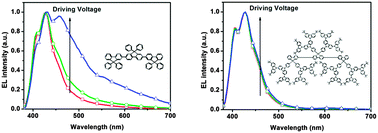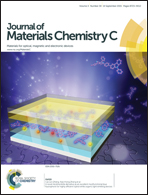Stable and efficient deep-blue terfluorenes functionalized with carbazole dendrons for solution-processed organic light-emitting diodes†
Abstract
A series of solution processible deep-blue fluorescent emitters TFPC0 ∼ TFPC2 have been designed and synthesized by incorporating different generation carbazole dendrons into the 9,9-positions of the terfluorene backbone. Compared with TFPC0, the dendritic TFPC1 and TFPC2 have the elevated glass transition temperatures as well as better solubility in common organic solvents, and their high quality amorphous films can be formed via spin-coating. Noticeably, with the increasing generation number, both the intermolecular aggregate and the formation of keto defects can be effectively suppressed to avoid the appearance of the unwanted long wavelength emission. Meanwhile, the highest occupied molecular orbital (HOMO) level is gradually enhanced from TFPC0 to TFPC2, facilitating the hole injection. As a result, TFPC2 with the second generation carbazole dendrons shows the best photoluminescence and electroluminescence stability among TFPC0 ∼ TFPC2. Its corresponding solution-processed undoped device gives a state-of-art external quantum efficiency as high as 2.02% and Commission International De L'Eclairge (CIE) coordinates of (0.16, 0.04). These results indicate that the introduction of oligocarbazole is a promising strategy towards solution processible deep-blue fluorene-containing oligomers simultaneously with high spectral stability and efficiency.


 Please wait while we load your content...
Please wait while we load your content...